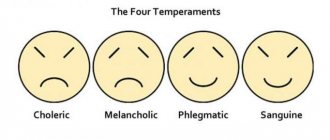A paradigm is a sample, an example, a model.
The Thinking Paradigm is a habitual model of thinking, thinking in a certain way, i.e. a habitual mental construct that has already become part of perception.
In essence, the Thinking Paradigm is a set of beliefs that shape our thinking. They are patterns of perception.
We see the world and perceive the events that happen to us through the prism of our own paradigm.
But it only seems to us that we see the world as it is. But in fact, we see him as we are.
Paradigm of Thinking
Everything you observe around you is your subjective perception. Everything you see, hear and feel is an image, a picture that emerges through your individual perception and belongs to the Space of Personal Perception .
Different people interpret and experience the same situation differently. It all depends on the settings of consciousness - what you fix your attention on, what you let into your life, and what you reject. All this is an integral part of your Thinking Paradigm.
If you learn to see your paradigms and change them, then you can significantly change the quality of your life and achieve the results that you need. Many of your paradigms hinder you because they are distorted. They influence how you communicate with yourself and with the world.
When you begin to see things differently than you are used to, then you begin to think and feel differently... A change in Paradigm entails a change in perception...
Once you see things as they really are, you will think, feel and behave differently. And this will happen automatically.
Your attitude and behavior are a consequence of your Thinking Paradigm. If you want changes in your life, then you need to work with your Paradigms.
There is a very good story about how our perception changes when we begin to see events from an unusual angle for us, that is, bypassing the usual Thinking Paradigm.
Half-empty subway car. Everyone is busy with their own business - some are reading, some are dozing. At one of the stations, a man with two children enters the carriage; they are somewhere between 6 and 8 years old. The man sits down in an empty seat, and the children begin to rush around the carriage. They shout at one another, touch passengers, and snatch newspapers from some of their hands. Their father sits with his head down and does nothing to calm the children down.
The woman sitting opposite him at some point cannot stand it, and, without hiding her irritation, turns to the man: “Your children are behaving indecently. Don’t you think that you should somehow pacify them?!” The man looked at her calmly and just as calmly replied: “Yes, I understand that I have to do something. But we are coming from the hospital where their mother died an hour ago. I think they don’t know how to deal with it... I don’t know how to deal with it myself.”
Well, how has your perception of what is happening changed? Now the situation where children behave disgracefully and their father does nothing sounds completely different. So you “looked at things completely differently.”
If you allow yourself to perceive situations not only from the perspective of what lies on the surface, then you will gradually change your Paradigms of Thinking and Perception. And vice versa, when you purposefully work towards changing your usual Paradigms, you will perceive situations from a completely different perspective.
Human Paradigm Metagalaxy
A paradigm (model, sample, example) is a set of fundamental scientific attitudes, ideas and terms accepted and shared by the community. In other words, a paradigm is a modern picture of the world. The paradigm can be scientific, state, generally accepted, personal (individual, subjective).
Different countries throughout their history have fulfilled one or another mission for humanity. Since ancient times, Russia was intended to form a new modern
Human. It is Russia, as the legal successor of the Soviet Union, note predictors, philosophers, historians and political scientists, that over the centuries of development has succeeded in the formation of a new Man (Man of the Metagalaxy) , a striking example of which was the Soviet Man - an excellent foundation for the future and the best historical precedent of the Soviet Union. In this process of forming a new man of a new era, CIS countries such as Ukraine, Belarus, and Kazakhstan also take a direct part. And since in the Metagalaxy, Yuri Gagarin spoke Russian for the first time , the passionate response of the formation of the Man of the Metagalaxy goes, first of all, to the Russian-speaking territory of the former Soviet Union.
We are talking about the creation by the Metagalactic Evolution of Man of a new natural formation - the Man of the Metagalaxy, the Man of a new era . After all, the Metagalactic Observer as a Man of the Metagalaxy is far from being a Planetary Observer - a person now living on the Planet. And the question is not only about observation - it is much broader! The question is in the principle and essence of the organization of the Man of the Metagalaxy himself.
What humanity previously achieved over the centuries of its development and existence is now becoming a common practice in the Metagalactic life of every Human. We have already made the biological leap predicted by science in the development of Man on the Planet. And this evolutionary leap introduced us with the Standards of the Metagalaxy into the evolutionary phenomenon of the Man of the Metagalaxy. And now we are slowly but surely being rebuilt and transformed by them. One or two generations of great time for us and a moment for the Planet, and everything will finally become visible to everyone. But the leap has been made right now, and we are present at the beginning of this great process. A Moment of History Completed!
Let us note the main identifications of the Man of the Metagalaxy:
- Based on the first Testament of Christ, who taught us to be a Heavenly Man, the Man of the Metagalaxy is distinguished by his 64 Parts in integrity, existing synthetically by the physical body and developed by 64 types of different Subnuclear Environment of the Metagalaxy . Common sense will easily suggest that the Heart, Soul or Mind, mentioned separately in the first Commandment, clearly received various expressions of the Trinity of the Heavenly Father. Simply because Human phenomena existed for different purposes.
But over the millennium after this, Man has grown: Thinking , and Consciousness , and Goloversum , and Faith , and Intellect , and Providence , and the Monad , synthetically expressing modern Man as parts of man . But new Metagalactic phenomena are also growing, forming the Metagalaxy in the synthesis of the 32 basic Parts of Man , including those mentioned earlier. Forces are now constantly fixed into the physical body of Man automatically, naturally and evolutionarily. They are invisible, like air in the lungs, very subtle and grow gradually only in those who are engaged in the development of the corresponding Parts. For the rest, it is simply a recording of the centuries-old evolutionary growth established by the Metagalaxy on the Planet. And the formation of a new Man of the Metagalaxy . It is logically clear that, like the organs of the human physical body, its expressions of Parts also exhibit different Properties and Qualities, Processes and Conditions, and therefore require completely different subnuclear processes of their organization, tailored to different results. This opportunity, which had been accumulating for millennia, finally occurred with a sharp evolutionary biological leap. The philosophy of Synthesis substantiated this as the Metagalactic Human Paradigm. Scientific and other knowledge, as it should be, will follow further, after this.
How did we prepare for the 64th? Remember chess, Shah-Mats (mothers) to each of us. We just saw eight and deciphered it. Dialectical materialism! And we no longer had time to laugh. Or let's remember the I-Ching, the book of Changes in China. Re-re-men!!! Where 64 types of living conditions (8×8) formed the prospects for a philosophical and figurative recognition of reality. But perhaps also fixation in the formation of something. After all, ancient Chinese philosophers were able to recognize exactly 64 streams of living conditions.
But if they were aimed at each person from ancient times, then they gradually developed certain processes in him, which led to the emergence of metagalactic-subnuclear Parts of the Human Metagalaxy - a new evolutionary stage in the life of the Metagalaxy. The Universe creates us! We thought that evolution was over and modern man was the pinnacle! Not yet! For a long time, oh, for a long time, the Metagalaxy was preparing us to leave the cradle! The time has come!
- Also, common sense will make it clear that the 64 streams of the Subnuclear forces of the Metagalaxy differ in some way from each other. Naturally, by the natural organization of the environment. But what is the essence of this? - In moderation!
Mathematics of the 21st century, now in progress, has already learned to solve multidimensional problems. Physics says that our world is no longer three-dimensional, as previously thought, but four-dimensional by quantum mechanics. But mathematicians have reached 11-dimensional solutions. This means that physics must become even more dimensional in reality, as Brian Greene’s theory of Super Strings . Let us remind you that the space that surrounds us is supposedly three-dimensional - length, width and height, what four-dimensionality is can be seen in the video lesson Doctor Quantum, what is dimensionality . But can we perceive everything? It's difficult to answer. Much depends on the capabilities and preparation of the Person. Science calls this the Observer Position . But if we have accustomed ourselves to three-dimensionality (and man is an adaptable creature), then the source of this adaptation could well be the trinity of the Parts of the Heavenly Man: Heart, Soul and Mind. But the Heavenly Father declared seven Spirits before the throne of the Lord! Seven Parts? The smart ones will exclaim: “Three, seven, ace.” What is Ace? I think this is the pinnacle of evolution - the Man of the Future, as we now understand, the Man of the Metagalaxy .
We turn to the religious context only because there is, in fact, NO science about Man!!! A person is more understood as the physiology or psychology of his body. But now it is one of the 64 Parts of Man! And what do we know about him? Generally? Here we are laying the philosophical paradigm for the future Metagalactic science. And the main thing in it is the science of Man. For we are building a state for him and politically proceeding from his needs!
Naturally, when perceiving the Position of the Observer, we see 3 parts three-dimensionally, which means that when perceiving the Position of the Observer, we see 64 parts in sixty-four dimensions! A lot of? But this is what the Metagalaxy is establishing on our Planet. Naturally. We don’t just have nowhere to go, we’ve already ENTERED into it!!! And therefore we publish it for you to jointly begin the process of understanding and organizing these processes. Accordingly, each Subnuclear stream presupposes one dimension of perception in the formation of one Part of Man. The physical environment has become the 256-dimensional subnuclear environment of the Metagalaxy, in which a new Phenomenon is born - the Man of the Metagalaxy.
- Modern Knowledge understands that 256 types of the Subnuclear Metagalactic environment, self-organizing, form stable layers of life among themselves , something like a layer cake, with different competences of activity and effects of environmental organization. We called these presences (at-the-Essence-of-phenomenon). And from now on, our physical presence of life (after all, life is present in this space of existence) has 256 levels of presence of various levels of self-organization of matter in the Metagalaxy.
But having thought about the sources of metagalactic subnuclearity, we recognized that the sources themselves are located Metagalactically on 4096 presences of the Metagalaxy, each of which has 256 layers of subnuclearity in reflection of each other by the Law of “Everything in everything”.
This means that the Metagalaxy expands our one-present physical world to a 256-present one. Thus, the Metagalaxy introduces us to the 256-ritsa of presences of the physical world by the phenomenon of fixing 256 Parts of Man for the future, one on each, by the phenomenon of the source of subnuclear forces that form this or that Part of Man. And at each of this presence it is expressed by 256 presences in a different Synthesis of Parts with each other, the growth of the integral interdependence of all before each and each before all by one type of subnuclearity of this part. Giving birth to the diversity of its activities.
In general, it’s time to learn to play chess not 8 by 8, but 64 by 64 =4096. The metagalaxy has arrived here and now!
- And what then about the presences in each of the 256 presences of the physical world of the Metagalaxy? And they are responsible for the formation of systems of Human Parts. We took the term from anatomy - the respiratory system, the circulatory system... We know the systems of Thinking - logical, formal, figurative, mythological. We know some types of systems of Consciousness - subconscious, unconscious. But it turns out we know so little about this!
In general, we are all just at the beginning of the Path of real knowledge of Man! And nature gives us a chance to immediately metagalactically understand it.
You can deepen and accelerate the process of learning the new capabilities of Man and retrain in accordance with the new standards described above by the Man of the Metagalaxy in the practical development of new Parts of Man in a special retraining program - Philosophical Readings of Synthesis . The content and themes of the Philosophical Readings of the Synthesis can be found here .
Friends, if you liked the article, please share it with your friends on social networks or leave a comment. It is important for the author to hear your opinion. Thank you for your feedback
Paradigms of the Subconscious
Subconscious Paradigms are a collection of habits embedded in our subconscious that determine our beliefs, perceptions, reactions and actions. The whole complex of subconscious programs that control our lives.
What is a habit? A habit is an idea that is fixed in the subconscious and on the basis of which we act without using our consciousness. Bypassing your consciousness, that is. It is these actions that lead us to certain results, and we have what we have.
If you still think that you live based only on your consciousness, then you are deeply mistaken. We are controlled by our subconscious. And this is our friend and protector. But, unfortunately, we poorly understand what is happening there. We can only draw conclusions after the fact, which is also important.
So, the actions that we take based on the ideas that “live” in our subconscious create our reality, which we then perceive as “our life.”
What happened to us when we were children influenced our subconscious. Certain ideas were formed in it, which were then transformed into algorithm schemes. They are the components of the Subconscious Paradigm.
The subconscious mind works in the background throughout our lives. It never sleeps, and we have the opportunity to interact with it at any time. You just need to know how to do it. And do this consciously, because living constantly in automatic mode under the influence of Subconscious Programs does not bode well.
Life flows in the format in which the Paradigms of Consciousness and Subconsciousness coincide. If they coincide in some kind of their algorithm-scheme, then everything works out - both desires are fulfilled and goals are achieved. And if they don’t match, then everything in life doesn’t work out—just problems and failures.
Touch, smell, hearing, sight, taste, perception, intuition, will, logic, imagination - all this belongs to the realm of consciousness. But not only him. The subconscious also does its job, we just don’t see these processes, we don’t notice them.
The human psyche is a tandem of consciousness and subconscious. But let’s make a small amendment - this is a tandem of the energy of consciousness, the energy of the subconscious and the general energetic state of the body-personality.
Definition of a Paradigm
The ideas, concepts and beliefs that you and others share about religion, nationality and other cultural subjects are likely an important part of your individual and collective identity, but how often do you consider where they came from or how they might change? In simple terms, a paradigm is a collection of beliefs and concepts that is a set of theories, assumptions and ideas that contribute to your worldview or create certain boundaries and limitations.
An example of a paradigm is the phrase “American way of life.” This phrase refers to a set of beliefs and ideas about what it means to be an American. For people who find this paradigm very important, it can serve as the basis for how they see or interact with the world around them. This highlights one of the most important features of a paradigm, which is that it consists of beliefs and ideas that form the basis for approaching and interacting with other things or people.
Psyche. Energy. Paradigms
Yes, you can’t live without energy. She's everywhere. And the laws by which the system called man and the system called the Universe operate are the same. And you need to know them. And they are based precisely on energy, on vibrations.
Consciousness functions on the basis of fuel - this is the energy that “flows” into our consciousness and allows us to “use” all the functions listed above. And it is very important what quality of energy “flows” into us.
The subconscious has its own energy resource. And if you learn to transfer this energy resource to the level of consciousness, then many things in your life will proceed exactly as you would like.
The energy stuck in the Subconscious does not allow our desires to come true very often. And it gets stuck there because that’s how defensive strategies work. But we have talked about this more than once, so we will not go into details.
Let's return to Paradigms. It is worth understanding that your success, achieving goals, fulfilling desires is the result of the coincidence of the Paradigms of Consciousness and Subconsciousness.
We get what we want only if the Paradigms coincide, i.e. when there is no conflict between consciousness and subconscious. By changing and balancing the Paradigms of Consciousness and Subconsciousness, we automatically release stuck energy in the Subconsciousness and bring it to the level of Consciousness. … to be continued …
CONSULTATION
If you need a consultation or just need to talk, discuss your pain, then you can contact me on WhatsApp. The first introductory conversation is within the framework of a free friendly conversation. This will be an introductory conversation and will not obligate you to anything. The rest will depend on your intentions and willingness to change something. You can also join our group EDGE OF MIND on WhatsApp
TO WRITE A MESSAGE
Perhaps you will
Where do paradigms come from?
In sociology, examples of paradigms emerged in the work of some key European philosophers, such as Karl Marx and Emile Durkheim, in the mid-to-late 19th century. Although they may not have specifically designated them as paradigms, these thinkers constructed a number of theories to explore how certain elements of society are connected or to solve social problems caused by, among other things, the growing power of capitalism. Throughout the 20th century, sociologists based their ideas on these earlier concepts and theories to form the basis of modern sociological approaches and traditions.
Life in the contexts of a paradigm...
Despite the fact that this short article is published in the “theoretical” section “Integral Neuroprogramming version 4.0”, it is very (and even very) practical. Because it represents a paradigmatic approach as an applied model for describing the opportunities and dangers of human life...
Let me start with the fact that, in a somewhat simplified version, each of the three aspects (“axes”) of the paradigm – dynamic, structural and substantive – can be represented by two features that seem to reveal its (aspect’s) essence. For dynamics, this is directionality and intensity. For structure – clarity and coherence. Well, for content – essence and meaning (meaningfulness).
And if within the framework of this “six” (easily displayed by a hexagram) we evaluate the etiology of problems in human life (and at any stage...), then in a dynamic sense they (problems) arise due to incorrectly chosen directions of self-realization and activity, as well as suboptimality efforts made to achieve the desired (usually insufficient, although sometimes excessive...). In the structural aspect, our “defeats” and “wrecks” are usually associated with insufficient clarity and definiteness of the structure of a specific area of being (up to its complete chaos...), as well as the inadequacy of connections between the elements of this structure and external, but important for it areas (in including as a result of their – connections – rupture or entanglement...). In terms of content - with an incorrect understanding of the essence (essence) and inadequate understanding of what we are dealing with. That is, in everyday language, we achieve neither success nor well-being mainly because we are going in the wrong direction, and while we are going, we are also lazy. We get confused in what is present and/or what is happening, and we also incorrectly build connections between its elements (and more often we simply break them: and above all, human ones...). And we also simply fill our lives with all sorts of nonsense, to which, moreover, we attach completely incorrect, but at the same time very sublime meanings, values and meanings...
A fairly simple illustration of this approach is the Japanese system of “auspicious” living, known to us as “Ikigai”. In which, in an amazingly wise and very practical way, the problem of dynamics (direction and intensity) is solved by the fact that you do (should do!) exactly what you want to do. The problem with structure (chaotization and suboptimal coherence) is that you know well and know how to do what you do. Well, the problem of content (essence and meaningfulness) is that you are doing what people really need. That is, the reasons for a “failing” life are related to the fact that you do what you don’t like and don’t want to do. You do it poorly not only because you don’t want to do it, but also because you don’t know how (and you don’t know how because you don’t like it...). And at the same time, you do what you don’t like and don’t know how to do, so that all this becomes completely unnecessary for people. At the same time (let me remind you of the paradigm of being from previous articles...) “I want to do” in general determines your freedom. “I can do it” means responsibility (only fools are willing to answer for what they can’t do...). And “people need this” - the meaning of your life...
The thoughtful reader may note, however, that for some reason I did not mention the fourth aspect of Ikigai: “It pays well.” So, I did this for a very simple reason. Even K. Jung, in his principle of “quaternity,” noted that this “fourth element” is born as an integrated sum of the three previous elements due to the process of their transition to a new quality. For example, the consistent development of three basic aspects of the psyche: sensations (dynamics); logic (structure) and emotions (content) lead to the emergence of intuition . So this sought-after aspect, which means a transition to a new level of any development (from financial to spiritual...), is always, so to speak, immanently present in the space formed by three basic axes: dynamics, structure and content. In this case, Ikigai can safely say that if you do what you like, do it well and skillfully, and also clearly and meaningfully understand that people really need it, in the resulting space you will not have any problems with decent pay. But the “loss” of any of the three basic elements of Ikigai simply guarantees you difficulties with adequate material compensation for your “lame” case, even if it is only on one “leg”...
In conclusion, here is another example of the application of a paradigmatic approach: to the problem of a healthy lifestyle. This very healthy lifestyle is possible if and only if you simultaneously have optimal motor activity (dynamics); normal, but for some reason called “healthy” nutrition (structure) and, oddly enough, really healthy sleep (content). Because only in this case, in the space of these three axes, the absolutely necessary “fourth element” of a healthy lifestyle appears: order, or, more precisely, orderliness of one’s own life...
Exercises
1). Take any area of your life (health, relationships, love, sex, work, material well-being, as well as the meaning of life) in which you feel pronounced disadvantage, and try to actively (i.e., translate into appropriate activity...) answer the question. next questions:
Am I going where I need to go in this area?
Am I going where I need to go with sufficient intensity?
Am I good at understanding the structure of the problem?
Have I created all the relationships necessary to resolve it?
Do I understand the essence of this matter or area of being well?
Do I have here (in this area) an adequate and sufficient set of meanings, meanings and values?
Try to understand and correct something based on your answers...
2). Assess and, if you can, optimize your life (in general or in a specific problem area...) from the point of view of the three aspects of Ikigai, namely:
Are you doing what you enjoy?
Can you really do this?
Do people really need what you do?
Please note that the above optimization may require significant effort from you and the competent application of integral neuroprogramming...
3). Just put things in order in your own life, without missing out on all three initial aspects of a healthy lifestyle...
Paradigm concept
When Einstein published his theories of general relativity, it was not just another idea that could fit comfortably into the existing paradigm. Instead, Newtonian physics itself was relegated to being a special subclass of the larger paradigm put forward by general relativity. Newton's three laws of motion are still taught in schools, but we now operate within a paradigm that places these laws in a broader context.
The concept of paradigm is closely related to Platonic and Aristotelian views of knowledge. Aristotle believed that knowledge can only be based on what is already known, based on the scientific method. Plato believed that knowledge should be assessed by what can become the final result or ultimate goal. Plato's philosophy is more like the intuitive leaps that bring about the scientific revolution.
Paradigm in rhetoric
It is a way of understanding something by giving an example and comparing one concept with another.
Marcus Fabius Quintilian, a Roman orator and teacher, taught his students rhetoric: beautiful speech, the art of persuasion. In his work “The Education of the Orator” (Institutio oratoria), he wrote that examples (or Greek paradeigmata - “paradigms”) are necessary in the art of persuasion.
For Quintilian, examples (paradigms) are analogous to the introduction to a speech. This is a way to convince the listener through argumentation, which consists of judgments and conclusions from them (syllogistic argumentation). He used examples from history, poetry, proverbs and phraseological units.
What is a paradigm and what does this word mean?
The word paradigm has Greek roots and translated means sample, model or example . In general, that’s all there is to it - you can finish the note without starting it. Well, no, you won’t wait...
A paradigm is a model (of anything, but most often this word is used in relation to science or a general worldview). In fact, this is a generally accepted model or example of how, at a given stage of development, one should approach solving problems in this area.
The concept of a paradigm can be applied both to global things (the same picture of the world that explains the world order, which changes with the change of milestones), and to rather narrow subjects of study (individual scientific disciplines, philosophy, morphology, etc.).
An example of generally accepted paradigms in linguistics for the Russian language are the rules for conjugating words, i.e. the same cases that we all learned at school (nominative, genitive, dative, accusative, instrumental and prepositional).
In simple words , the paradigm is the very stove from which everyone is now dancing. It is an established template at a given time, using which one can solve problems facing science or any other field of application of knowledge. It helps to sort the acquired knowledge and experience into existing shelves, systematize them and simplify work.
For example, the main paradigm that shapes our current picture of the world is the Big Bang Theory (not to be confused with the TV series of the same name). An example of an outdated paradigm is the relatively recently popular model of a flat earth (oddly enough, there are still those who adhere to it) or the earth located in the center of the universe.
Usually, a change in scientific views (revolutionary changes) is associated precisely with a change in paradigm. As a rule, any model initially has flaws that are neglected, tried not to be noticed, or even deliberately hushed up.
But when the number of identified flaws exceeds a certain value, processes may begin leading to the search for a new paradigm , which at this stage will be more general in nature and have fewer flaws. According to the law of dialectics, quantity turns into quality.
This model is gradually becoming generally accepted until a sufficient number of contradictions accumulate again for its general negation and the transition to a new model that better suits the new reality (having a larger number of suitable shelves on which new knowledge acquired about the subject of study can be placed). This is how a paradigm shift occurs.
For example, the picture of the world formulated in the time of Aristotle was replaced by a new paradigm of classical natural science in the time of Newton. And now Einstein’s relativistic theory has more weight. The same revolutionary phenomenon that led to a change in the model was Darwin's theory of the origin of species. Now they are actively trying to challenge it, but so far there has been no change in milestones.
However, paradigms do not always replace each other . Sometimes they successfully coexist and complement each other. For example, wave and quantum theories, as well as a number of other theories that try to eliminate their dualism. Although, this may only be a protracted stage of changing the model, when the “ideal” that satisfies the majority has not yet been found.
Paradigms are historically and culturally related (Thomas Kuhn)
A modern Chinese medical researcher with a background in Eastern medicine will operate within a different paradigm than a Western physician of the 1800s. Where does a paradigm come from? Philosopher Thomas Kuhn was interested in how the overarching theories we have of reality itself influence the models and theories we use within a paradigm that dictates the following:
- what is observed and measured;
- the questions we ask about these observations;
- how these questions are formulated;
- how to interpret the results;
- how the research is conducted;
- what equipment is suitable.
Many students who choose to study science do so with the belief that they are pursuing the most rational path to learning about objective reality. But science, like any other discipline, is subject to ideologies, biases, and hidden assumptions. In fact, Kuhn strongly suggested that research into a deeply entrenched paradigm invariably terminates that paradigm, since anything that contradicts it is ignored or persecuted by given methods until it conforms to the already established dogma.
The body of existing evidence in the field shapes the collection and interpretation of all subsequent evidence. The belief that the current paradigm is reality itself is precisely what makes it so difficult to accept alternatives. Although Kuhn focused on the sciences, his observations about scientific paradigms apply to other disciplines.
What is a paradigm shift?
Shift occurs when one paradigm theory is replaced by another. Here are some examples:
- The astronomy of Ptolemy gives way to the astronomy of Copernicus.
- The physics of Aristotle (which argued that material objects had an essential nature that determined their behavior) gives way to the physics of Galileo and Newton (who viewed the behavior of material objects as governed by the laws of nature).
- Newtonian physics (which held time and space the same everywhere, for all observers) gives way to Einsteinian physics (which held time and space relative to the observer's frame of reference).










